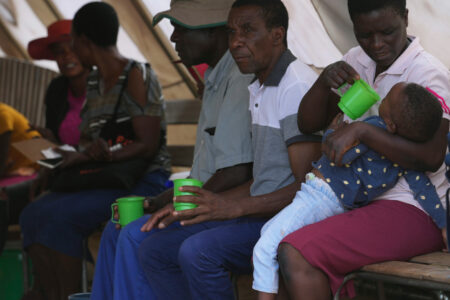
(This article has been translated from French.)
We are experiencing an unprecedented situation. The crisis caused by COVID-19 has not just health, social and economic implications but also media implications, as its coverage completely overshadows all other events happening on the planet at the moment. It is a media eclipse unlike anything we have ever seen before.
What is a media eclipse? A media eclipse is the concentration of news around a single event or theme of such magnitude that there is little or no room left to discuss other issues. As soon as more than 20 percent of the media space is occupied by a theme, it is usually referred to as a media eclipse. The event can be the death of a public figure, a natural or man-made disaster, an unexpected political upheaval or a media frenzy linked to a social issue. This event then leaves no room for other news.
The coronavirus is far more than 20 percent of the media space; it alone occupies all the current space. Recent important issues such as the claims of Indigenous people, who a few weeks ago were blocking the railways to assert their rights, or the environmental crisis, have all but disappeared from coverage. It is the same at the international level, where the refugee crisis or the war in Syria are no longer in the headlines because of the media eclipse.
The last major media eclipse we experienced in Quebec was that of the Values Charter. At that time, the famous Charter overshadowed all other news for at least a month. Globally, September 11, 2001 was the historic media eclipse of this century to date, when the eyes of the entire world were on the United States and live coverage marked the media landscape.
Upon the death of a public figure, the media eclipse usually ends with the final tributes paid to him or her. In the case of major disasters or social upheavals, it is rather the resolution of the situation that coincides with the end of the eclipse. However, as the COVID-19 crisis shows, such a resolution will not be quick. As with the 9/11 attacks, the coronavirus is expected to make headlines for several weeks or even months yet. Other crises also fall into oblivion when there is no quick resolution and also because the news is no longer news as the situation drags on or is no longer as interesting to cover for the media. Think of the refugee crisis or the aftermath of tsunamis. Once the impressive dimension of the events is covered, it becomes more difficult to make headline news. In short, the time factor and also novelty factor as well as spectacular nature of the news are key elements in media eclipses.
The effects of a media eclipse are diverse. Among the most important is the concentration of all media resources on the issue in question. In the current context of traditional media’s lack of financial resources and the weakening of their business model, which is accentuated by the crisis (particularly by a further decline in advertising), it is difficult for the media to cover anything other than COVID-19 or to try to find innovative angles to analyze it. Moreover, an important part of the work of journalists is to cover political news, which also revolves around COVID-19 at the moment. This has a cascade effect – as politicians speak almost exclusively on this issue, the media devote a lot of reporting time to it, exposing the public to a large volume of information about the coronavirus. All of it adds to the media eclipse.
It is also difficult for the media to talk about anything else right now because this crisis is unprecedented and has a phenomenal place in everyone’s life, as it affects all social and economic sectors and affects all people. The population is seeking information by all means. The media are seeing their role as watchdogs of democracy and chief informers amplified and taking on critical importance, especially in the age of fake news and disinformation.
As for the role of social media in this media eclipse, we are living in an era of media hybridization where traditional media and digital media intertwine and adapt to each other in an increasingly fluid environment. Thus, the media eclipse is experienced in all types of media, as news is picked up by citizens, governments, businesses and other organizations on multiple platforms, including Facebook, Twitter and Instagram. In Quebec, the keywords from the daily press conferences of Premier François Legault and his team quickly become clickable words and then circulate on social media.
In a way, this phenomenon is analogous to “citizen marketing,” where citizens share political opinion on social media and are thus participating in political marketing. Indeed, users of these platforms can both amplify the messages they deem relevant by sharing them with their own network and reshape them to express their concerns (notably through the creation of Internet memes).
Media eclipses also present challenges for citizens, businesses and governments. Citizens, overwhelmed with all kinds of information, must keep in mind substantive questions about the source of the information and its reliability. They can also consult news verification sites such as the Décrypteurs or those of accredited organizations such as the International Fact-Checking Network.
Many companies are also wondering how they can take advantage of this eclipse without shocking their clients. Some are doing this by incorporating fun proposals into their offerings. Examples include the Quebec-based department store Simons, which offers tips through its newsletter, or celebrity chefs Ricardo or Jamie Oliver, who, deprived of their daily shows, broadcast their recipes on Facebook or Instagram.
Some companies may be tempted to take advantage of the media eclipse to announce bad news (the closing of a factory, for example), hoping that it will pass under the radar of journalists whose energies are mobilized to deal with the crisis. On the other hand, this approach could have negative medium- and long-term repercussions for the company and damage its reputation.
As for governments, all their efforts are focused on managing the crisis – protecting everyone’s health, financially supporting citizens and businesses, and repatriating Canadians still abroad. Legislation is being put on hold until the crisis is over. In addition, policy-makers must quickly adopt “best practices” in crisis communication by imposing a framework for interpreting the situation, mobilizing their experts to explain the situation clearly and reassuringly, and putting in place progressive measures. To do so, they use traditional approaches such as press conferences or advertising, but also make use of social media. Another challenge is to respect their areas of jurisdiction and avoid possible discrepancies between provincial and federal measures, among others.
Ultimately, however, the greatest challenge facing governments and the media today is to keep citizens’ attention throughout this media eclipse. An overload of information can weary the public of a particular topic, which is counterproductive from a broad communication perspective.
Finally, as the crisis generates many emotions – fear, anxiety, sadness, worry – and as the media eclipse does not allow people to escape from this tsunami of information, citizens may be tempted to turn off their radios, televisions or cell phones in order to find some respite in this media storm. Many are already doing so. Thus, they may not receive important information about the health crisis, information that would allow them to better protect themselves. Finally, others will choose to inform themselves only sporadically or by selecting certain news items that could expose them to false news and potential misinformation.
This article is part of the The Coronavirus Pandemic: Canada’s Response special feature.
Photo: Shutterstock, by stockphoto mania.











